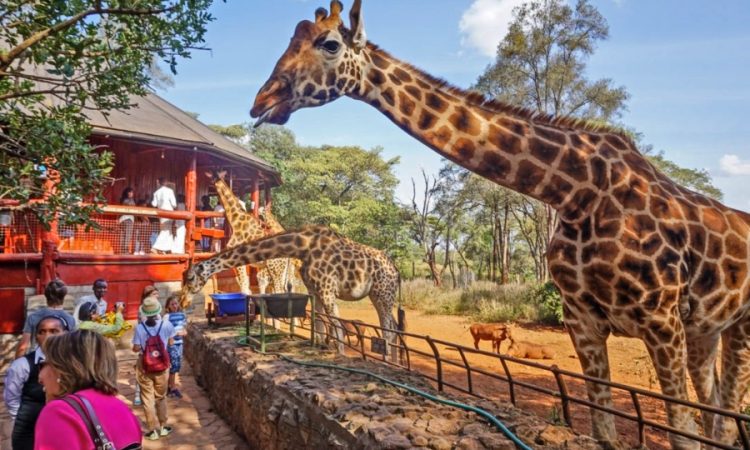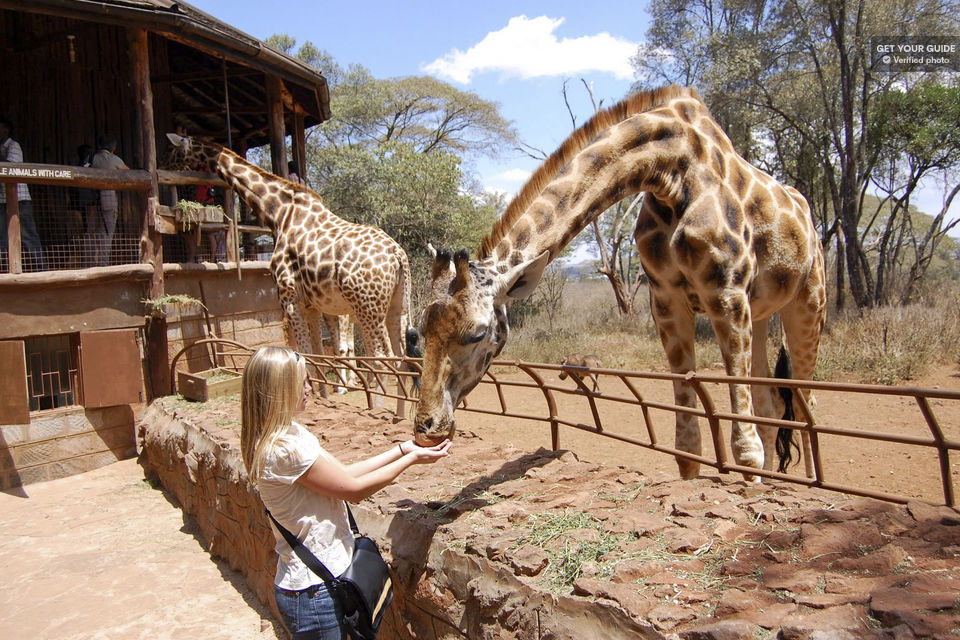The Nairobi Giraffe Center : You carefully put the molasses pellets, which are in your hands, one by one onto the impatient giraffe’s outstretched gray tongue. A visit to the Giraffe Center is a terrific way to get up close and personal with Africa’s tallest mammal while also directly supporting conservation efforts for the endangered Rothschild giraffe.

THE GIRAFFE CENTRE, AT A GLANCE
The severely endangered Rothschild giraffe, who are unique among giraffe subspecies in that they lack patterning below the knee, is greatly dependent on the African Fund for Endangered Wildlife Giraffe Centre, also known locally as The Giraffe Centre.
There were only about 100 Rothschild’s giraffes left in the wild prior to conservation efforts because of habitat degradation and mass poaching. After rearing a Rothschild giraffe, Daisy, in their Langata house, Betty and Jock Leslie Melville (a grandson of a Scottish earl) established the fund in 1979. Today, the population has doubled to 300 throughout Kenya as a result of their conservation efforts.
You may observe the giraffes up close and feed them by hand from the elevated wooden platform, sometimes known as “giraffe height.” Additionally, you might see warthogs nibbling at their hooves as they scavenge the dropped pellets.
On your way out, stop by the Daisy Souvenir Shop to pick up some mementos or unwind with a pot of tea at the tea house. 90% of the money raised for the giraffe center comes from the tea house, curio shop, and admission charge.
After seeing the giraffes, you can take a 1.5-kilometer self-guided woodland walk in the nearby Gogo River Sanctuary, which offers stunning views of Nairobi and the Ngong Hills.
VISITING THE GIRAFFE CENTER
Visit Nairobi’s Giraffe Center to get a glimpse of some of the largest creatures on the planet. The primary goal of the African Fund for Endangered Wildlife (AFEW) Center is to safeguard the endangered Rothschild giraffe, Giraffa camelopardalis rothschildi, which is known to graze freely and in protected confinement in East African meadows. The initiative has been incredibly successful over the years, introducing a few Rothschild giraffe breeding kinds into Kenyan national parks. Other wildlife includes many domesticated warthogs and a 95-acre (40-hectare) forested nature sanctuary across the road, which is an excellent place to go birdwatching.
The cost of admission is $15 USD per person, or roughly KSh 1,500 in Kenyan shillings. The daily hours for visiting are 9 a.m. to 5 p.m. For an additional fee, you may choose to combine this tour of Nairobi with a visit to the neighboring David Sheldrick Wildlife Trust Elephant Nursery and a lunch break at a quaint local restaurant.
WHERE DOES THE GIRAFFE CENTER FIT INTO YOUR AFRICAN SAFARI ADVENTURE?
The Giraffe Center is located in the suburb of Langata, on the outskirts of Nairobi. Depending on traffic, it’s only a short drive from the city center.
The best way to see giraffes at the center is to combine it with an early morning game drive in Nairobi National Park, which is home to four of the Big Five and the closest national park to any capital city.
Next, a visit to the Sheldrick Wildlife Trust Elephant Orphanage, where the young elephants rush to get milk between the hours of 11 a.m. and 12 p.m.
Next, proceed to the Nairobi Giraffe Centre, where you may feed the critically endangered Rothschild giraffes by hand from an elevated observation platform.

When combined, the three trips account for a whole day, so if you’re planning a longer safari in Kenya, it’s worth adding an extra day in Nairobi to accommodate them.
WHERE TO STAY WHEN VISITING GIRAFFE CENTER?
Giraffe Manor: Constructed in the 1930s, this boutique hotel is distinguished by its expansive windows, verdant creepers, lovely sunny terraces, and verdant courtyards.
The ever-present population of endangered Rothschild giraffes, who frequently poke their heads through the open windows while you savor a continental breakfast, is what really sets Giraffe Manor apart.
A few rooms have access to private patios where guests may relax in the afternoon sun and watch giraffes approach in search of goodies.
WHEN SHOULD YOU GO?
To avoid scheduled excursions being ruined by rain, the Giraffe Center is best visited in the dry season, which runs from December to March and June to October. Nonetheless, guests can visit the center any time of year.
The feeding platform is covered in case of rain, and it will be less crowded during the wet seasons of March to May and late October to early December. These are nevertheless wonderful times to come. Like anything in Kenya, reservations must be made long in advance if you’re traveling during the busiest time of year.


